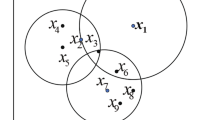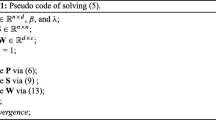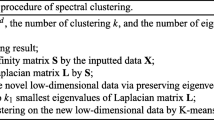Abstract
Affinity matrix construction is a key step in the spectral clustering. However, traditional spectral clustering methods usually ignore the intersection problem that may exist between the different clusters of data, so the resulting matrix could be unreliable. This paper proposes a new local covariance-based method to solve the above problem. Specifically, we first learn an initial affinity matrix by adding the local covariance into traditional matrix construction step, which could guarantee the obtained matrix avoids the impact of the intersection point while preserving the neighborhood relationship of data. We then employ the normalized Laplacian on the obtained matrix to further improve the clustering performance. The ACC and NMI of the proposed method increased by 6.40% and 5.33% on average compared with six classical spectral clustering methods. Experimental evaluation on eight benchmark data sets shows that the proposed method has better clustering performance.

Similar content being viewed by others
References
Zhang Y, Zhao O, Jing J, Wang X, Cichocki A (2012) A novel bci based on erp components sensitive to configural processing of human faces. J Neural Eng 9(2):026018
Yang Y, Duan Y, Wang X, Ning X, Zi H, Shen H (2018) Hierarchical multi-clue modelling for poi popularity prediction with heterogeneous tourist information. IEEE Trans Knowledge Data Engine. https://doi.org/10.1109/TKDE.2018.2842190
Gao L, Guo Z, Zhang H, Xu X, Shen H (2017) Video captioning with attention-based LSTM and semantic consistency. IEEE Trans. Multimed 19(9):2045–2055
Zheng W, Zhu X, Wen G, Zhu Y, Yu H, Gan i (2018) Unsupervised feature selection by self-paced learning regularization. Pattern Recognit Lett. https://doi.org/10.1016/j.patrec.2018.06.029
Zhu X, Suk HI, Huang H, Shen D (2017) Low-rank graph-regularized structured sparse regression for identifying genetic biomarkers. IEEE Trans Big Data. https://doi.org/10.1109/TBDATA.2017.2735991
Zhu X, Suk H I, Seong W, Lee L W, She D (2015) A novel relational regularization feature selection method for joint regression and classification in ad diagnosis. Med Image Anal 75(6):570–577
Zhu X, Li X, Zhang S (2017) Block-row sparse multiview multilabel learning for image classification. IEEE Trans Cybern 46(2):450–461
Song J, Gao L, Nie F, Shen H, Sebe N (2016) Optimized graph learning using partial tags and multiple features for image and video annotation. IEEE Trans Image Process 25(11):4999–5011
Zhu Y, Zhu X, Kim M, Kaufer D, Wu G (2017) A novel dynamic hyper-graph inference framework for computer assisted diagnosis of neuro-diseases. In: International conference on information processing in medical imaging, pp 158–169
Zhu X, Li X, Zhang S, Chunhua J, Xindong W (2017) Robust joint graph sparse coding for unsupervised spectral feature selection. IEEE Trans Neural Netw Learn Syst 28(6):1263–1275
Zhu Y, Kim M, Zhu X, Yan J, Kaufer D, Guorong W, Minjeong K, (2017) Personalized diagnosis for Alzheimer's disease. Med Image Comput Comput Assist Interv 10435: 205–213. https://doi.org/10.1007/978-3-319-66179-7_24
Zhu Y, Zhu X, Kim M, Yan J, Kaufer D, Kaufer D, Wu G (2018) Dynamic hypergraph inference framework for computer assisted diagnosis of neurodegenerative diseases. IEEE Trans Med Imaging. https://doi.org/10.1109/TMI.2018.2868086
Aloise D, Deshpande A, Hansen P, Popat P (2009) Np-hardness of euclidean sum-of-squares clustering. Mach Learn 75(2):245–248
Guha S, Mishra N (2016) Clustering data streams. Springer, Berlin
Dubes R, Jain AK (1979) Validity studies in clustering methodologies. Pattern Recognit 11(4):235–254
Zhu X, Li X, Zhang S, Xu Z, Yu L, Wang C (2017) Graph pca hashing for similarity search. IEEE Trans Multimed 19(9):2033–2044
Shen F, Xu Y, Liu L, Yang Y, Huang Z, Shen H (2018) Unsupervised deep hashing with similarity-adaptive and discrete optimization. IEEE Trans Pattern Anal Mach Intell. https://doi.org/10.1109/TPAMI.2018.2789887
Kanungo T, Mount DM, Netanyahu NS, Piatko CD, Silverman R, Angela Y (2002) An efficient \(K\)-Means clustering algorithm: analysis and implementation. IEEE Trans Pattern Anal Mach Intell 24(7):881–892
Zhu J, Wang H (2010) An improved K -means clustering algorithm. IEEE International Conference on Information Management and Engineering 9(1):44–46
Lei C, Zhu X (2018) Unsupervised feature selection via local structure learning and sparse learning. Multimed Tools Appl 77(22):29605–29622
Zheng W, Zhu X, Zhu Y, Hu R, Lei C (2017) Dynamic graph learning for spectral feature selection. Multimed Tools Appl. https://doi.org/10.1007/s11042-017-5272-y
Wierzcho ST, Kopotek MA (2018) Modern algorithms of cluster analysis. Spectral clustering. Springer. https://doi.org/10.1007/978-3-319-69308-8
Ng AY, Jordan MI, Weiss Y (2001) On spectral clustering: analysis and an algorithm. In: Proceeding NIPS 14:849–856
Zhu X, Zhang L, Huang Z (2014) A sparse embedding and least variance encoding approach to hashing. IEEE Trans Image Process 23(9):3737–50
Zhu X, Zhang S, He W, Hu R, Lei C, Zhu P (2018) One-step multi-view spectral clustering. IEEE Trans Knowl Data Eng. https://doi.org/10.1109/TKDE.2018.2873378
Li X, Guo L (2012) Constructing affinity matrix in spectral clustering based on neighbor propagation. Neurocomputing 97(1):125–130
Wang S, Chen F, Fang J (2015) Spectral clustering of high-dimensional data via nonnegative matrix factorization. In: International joint conference on neural networks. https://doi.org/10.1109/IJCNN.2015.7280465
Zhang X, Li J, Hong Y (2011) Local density adaptive similarity measurement for spectral clustering. Pattern Recognit Lett 32(2):352–358
Peng X, Zhang L, Yi Z (2013) In: Scalable sparse subspace clustering. pp 430–437
Bhissy K, Faleet F E, Ashour W (2014) Spectral clustering using optimized gaussian kernel function. Int J Artif Intell Appl Smart Dev 2(1):41–56
Nataliani Y, Yang M-S (2017) Powered gaussian kernel spectral clustering. Neural Comput Appl. https://doi.org/10.1007/s00521-017-3036-2
Li Z, Tang J (2015) Unsupervised feature selection via nonnegative spectral analysis and redundancy control. IEEE Trans Image Process 24(12):5343–5355
Li Z, Sun S, Li M (2017) A clustering methods and relevant application of panel data based on euclidean space-time distance. Bol Tech Bull 55(5):350–361
Zhang S, Li X, Zong M, Zhu X, Wang R (2018) Efficient knn classification with different numbers of nearest neighbors. IEEE Trans Neural Netw Learn Syst 29(5):1774–1785
Song J, Shen H, Wang J, Huang Z, Sebe N, Wang J (2016) A distance-computation-free search scheme for binary code databases. IEEE Trans Multimed 18(3):484–495
Rustam Z, Talita A S (2017) Fuzzy kernel K-Medoids algorithm for anomaly detection problems. In: AIP conference proceedings. https://doi.org/10.1063/1.4991258
Har-Peled S, Mazumdar S (2004) On Coresets for K-Means and k-Medians clustering. In: Annual Acm symposium on theory of computing. https://doi.org/10.1145/1007352.1007400
Tripathy BK, Goyal A, Sourav P A (2016) A comparative analysis of rough intuitionistic fuzzy \(K\)-Mode algorithm for clustering categorical data. Res J Pharm Biol Chem Sci 7(5):2787–2802
Zelnik-Manor L, Perona P (2004) Self-tuning spectral clustering. Adv Neural Inf Process Syst 17:1601–1608
Hadjighasem A, Karrasch D, Teramoto H, Haller G (2016) A spectral clustering approach to Lagrangian vortex detection. Phys Rev E 93(6–1):063107
Li Y, Liu W (2016) Scalable sequential spectral clustering. In: Thirtieth AAAI conference on artificial intelligence, pp 1809–1815
Binkiewicz N, Vogelstein JT, Rohe K (2017) Covariate-assisted spectral clustering. Biometrika 104(2):361–377
Singh D, Febbo PG, Ross K, Jackson DG, Manola J, Ladd C, Tamayo P, Renshaw AA, D’Amico Anthony V, Richie JP (2002) Gene expression correlates of clinical prostate cancer behavior. Cancer Cell 1(2):203–209
Shi J, Malik J (2000) Normalized cuts and image segmentation. IEEE Trans Pattern Anal Mach Intell 22(8):888–905
Peng X, Feng J, Xiao S, Lu J, Zhang Y, Shuicheng Y (2017) Deep sparse subspace clustering. In: Computer vision and pattern recognition. http://arxiv.org/abs/arXiv:1709.08374
Hu R, Zhu X, Cheng D, He W, Yan Y, Song J, Zhang S (2017) Graph self-representation method for unsupervised feature selection. Neuro comput 220:130–137
Zhu X, Zhang S, Rongyao H, Zhu Y, Song J (2018) Local and global structure preservation for robust unsupervised spectral feature selection. IEEE Trans Knowl Data Eng 30(3):517–529
Zhu X, Zhang S, Li Y, Zhang J, Yang L, Fang Y. Low-rank sparse subspace for spectral clustering. IEEE Trans Knowl Data Eng. https://doi.org/10.1109/TKDE.2018.2858782
Jain P, Kakade S M, Kidambi R, Netrapalli P, Sidford A (2018) Parallelizing stochastic gradient descent for least squares regression: mini-batching, averaging, and model misspecification. J Mach Learn Res 18(223):1–42
Wang S, Yuan X, Yao T, Yan S, Shen J (2011) Efficient subspace segmentation via quadratic programming. In: AAAI conference on artificial intelligence, pp 519–524
Santos JM, Embrechts M (2009) On the use of the adjusted rand index as a metric for evaluating supervised classification. In: Lecture Notes in Computer Science, vol 5769. Springer, pp 175–184
Yeh C-C, Yang M-S (2017) Evaluation measures for cluster ensembles based on a fuzzy generalized rand index. Appl Soft Comput 57:225–234
Acknowledgements
This work is partially supported by the China Key Research Program (Grant No: 2016YFB1000905); the Key Program of the National Natural Science Foundation of China (Grant No: 61836016); the Natural Science Foundation of China (Grants No: 61876046, 61573270, 81701780 and 61672177); the Project of Guangxi Science and Technology (GuiKeAD17195062); the Guangxi Natural Science Foundation (Grant No: 2015GXNSFCB139011, 2017GXNSFBA198221); the Guangxi Collaborative Innovation Center of Multi-Source Information Integration and Intelligent Processing; the Guangxi High Institutions Program of Introducing 100 High-Level Overseas Talents; and the Research Fund of Guangxi Key Lab of Multi-source Information Mining & Security (18-A-01-01).
Author information
Authors and Affiliations
Corresponding author
Ethics declarations
Conflict of interest
We wish to draw the attention of the editor to the following facts which may be considered as potential conflicts of interest and to significant financial contributions to this work. We confirm that the manuscript has been read and approved by all named authors and that there are no other persons who satisfied the criteria for authorship but are not listed. We further confirm that the order of authors listed in the manuscript has been approved by all of us. We understand that the corresponding author is the sole contact for the editorial process (including editorial manager and direct communications with the office). He/she is responsible for communicating with the other authors about progress, submissions of revisions, and final approval of proofs. We confirm that we have provided a current, correct e-mail address which is accessible by the corresponding author and which has been configured to accept e-mail from: 2017010430@stu.gxnu.edu.cn.
Rights and permissions
About this article
Cite this article
Du, T., Wen, G., Cai, Z. et al. Spectral clustering algorithm combining local covariance matrix with normalization. Neural Comput & Applic 32, 6611–6618 (2020). https://doi.org/10.1007/s00521-018-3852-z
Received:
Accepted:
Published:
Issue Date:
DOI: https://doi.org/10.1007/s00521-018-3852-z




